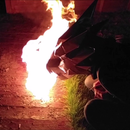Introduction: .50 Cal Coil Gun
Youtube video of it in action.
This would mean a dramaticaly larger capacitor bank and equally large solid state switches. Whilst under construction I was approached by a Professor in the Engineering Department asking whether I could adapt it for use as a demonstration piece on electromagnetic acceleration. It only involved a few safety measures so I agreed and they gave me funding for components. The big buy was going to be a high current and voltage solid state switch. Luckily a Mitsubishi CM400HU-24F IGBT was supplied by a member of staff in the department who works on the power systems in trains.
Step 1: The Theory
A coil gun works on the principle of electromagnetic attraction. The coil gun itself is akin to an air cored solenoid. A ferromagnetic armature is placed at the breach of the coil and is electromagnetically attracted towards the centre of the coil when a current is passed though the coil. When the armature reaches the centre of the coil it will start actively decelerating if the current is still passing through the coil as it is magnetically attracted to the midpoint of the coil. This means that the current pulse length needs to be of a finite length in order for the armature to be accelerated up to the centre of the coil and not ‘sucked back’ as it tries to leave the coil via the other end. This is more specifically a ‘reluctance coil gun’, a diagram is shown below.
This is the biggest disadvantage to coil guns, the current pulse length needs to be controlled in order to cut the power when the armature reaches the middle of the coil.
The second largest challenge to overcome with coil guns is delivering the electricity as quickly as possible. It stands to reason that the more energy you can put onto the coil gun, the more energy will be transferred into kinetic energy in the armature.
The main losses in this system are the eddy currents in the flyway tube and the projectile/armature, these can be minimised by slotting the flyway tube or using a non-conductive material. The projectile must be ferromagnetic thus this means that limiting eddy currents cannot be achieved by using a non-conductive material. The best solution to this is to use a powdered Iron in epoxy resin matrix. Although this improves initial efficiency it also removes the ability for the gun to be operated as an ‘inductance coil gun’.
Step 2: Things to Consider When Designing
Projectiles
I've done a separate Instructable on Projectile Design since it is such a big section.
Coil Length
The longer the coil is the more time it has to drag the projectile to the centre and the more wraps of wire can be fitted into the solenoid increasing magnetic flux density. The longer the piece of wire the coil is made of and the higher the inductance of the coil the higher the reluctance of the coil is so the longer the current pulse length will be. This means that the rate of change of current is lower and so will not reach as high a peak value. Since the current effects the magnetic field density a high current is desirable so the coil should be tuned so that it makes the strongest magnetic field in the time available.
The coil length is directly linked to the projectile length as they should be roughly equal as mentioned previously.
Number of layers in the coil
More layers mean a stronger magnetic field but it also means higher impedance and so a longer pulse length. If the pulse length is too long then the projectile will experience ”suck back” and have a lower exit velocity, optical triggering can be used to solve this problem.
Too many layers will mean that the magnetic field of the outer layers adds no strength the magnetic flux density in the centre where the projectile is and so the energy is wasted. It also means that the pulse length is unnecessarily long so the current will not rise as sharply as otherwise possible.
Thickness of coil wire
Thicker wire means lower impedance so a faster pulse length and higher peak current. This means less wraps in the coil per unit area so the flux density is potentially reduced if the current isn’t significantly increased by the lower impedance. If the wire is too thin it will have too high a resistance and get unnecessarily hot. In extreme cases it can burn out on firing.
Pulse Length
The pulse length should be exactly the same length as the amount of time it takes to pull the projectile from the breach to the centre of the coil and return to zero. The pulse length is affected by a myriad of variables including, capacitor voltage, capacitor capacity, circuit resistance, and coil inductance which varies dynamically during use as there is initially an air core which is soon replaced with an iron core as the projectile slides in not to mention depending on how many turns, layers and what gauge of wire is used.
This problem is solved by fixing as many variables as possible such as capacitor voltage and size, projectile dimensions which in turn fix the coil length and internal diameter. Then the remaining variables are varied until the optimal combination is found. The remaining variables are most importantly wire gauge and number of layers. Assuming a suitable switch can be used the wire gauge is usually the largest available.
Switch bounce/resistance
Mechanical switches can arc and bounce which lengthens the pulse and lowers the average flux density experienced in the tube during firing. This is overcome by the use of solid state switches such as SCR’s, MOSFET’s or IGBT’s which experience none of the arcing issues. They are not perfect solutions though as they have several flaws such as requiring a switching current/voltage to work and SCR’s cannot be switched off until the source-drain current drops below zero so require “v-switching”. V-switching is where a second SCR and cap bank of the same or higher voltage is discharged through the first SCR dropping the voltage below zero and switching the switch off.
MOSFET’s are generally quite low power so are of no use to coil guns of a decent scale and a suitable one can be expensive but a solution is to use a bank of them is parallel to spread the current over several less expensive devises. IGBT’s are much better solutions as they can be switched on and off at will and can handle far higher power than MOSFET’s. It is also important that the solid state switch can operate fast enough to turn the device on and off in the desired time frame, Most IGBT’s are capable of this as well.
Capacitor Voltage
The higher the capacitor voltage the higher the projectile velocity since the stored energy in a capacitor is equal to half the capacitance multiplied by the voltage squared as long as the switching capabilities are there then this is one of the more favourable variables to choose to increase as each extra volt makes a big difference.
Capacitor Capacitance
The higher the capacitance the larger the volume of stored energy in line with:
Energy stored in a capacitor=1/2 CV^2
Coil Flux Linkage (external Iron)
Adding an external iron shell to the coil can improve the flux linkage between the coil and the projectile but care must be taken to eliminate Eddie current losses. A powdered iron matrix or ceramic ferrite is therefore the best option. The External iron must not have too much mass as the extra iron material will slow the magnetic flux build up and the coil gun may not saturate as not all of the ferrous material is magnetised which means it is dead weight and just slows the flux density increase rate. This would mean that the magnetic flux would not increase as rapidly and not reach as high peak value. Too little ferrous material means it is potentially wasting the magnetic flux available.
The External iron must therefore be optimised so that it does not saturate and yet there is enough to enhance the magnetic flux density. It will affect the inductance of the coil and so the current pulse length so the coil may need to be of a slightly different shape to gain optimal performance.
Minimise connecting wire length
All connecting wires between the coil and the capacitors should be as short and thick as possible to reduce resistive losses and inductance.
Step 3: The Design
Capacitor bank size
A bank of 40 330v photoflash capacitors of 100uF capacity where used giving a total energy capacity of 217.8J:
E=1/2 CV^2
E=1/2*4000x10^(-6)*330^2
E=217.8J
Switching
Only solid state switches would work for this project as any other switches would arc. I was supplied with an IGBT capable of handling up to 1200V and 800A Peak and a maximum full switching on and off time of 1300ns. This is fast enough and can handle far more volts than needed but the current is only just enough. It switches at up to +/- 20v.
Charging
A 1.5v to 400 volt inverter has been included in the enclosure to enable the device to be charged of AA batteries but this would be slow and would use several batteries per shot. The main charging comes from half rectified mains using a light bulb as a charging resistor to give non-linear resistance through the charge cycle. UK mains electricity is 240v RMS, which when half wave rectified using a diode comes out at 336v. My capacitors charge up to 330 volts so 336 is perfect and mains will allow me to charge the bank cheaply and quickly when compared to the battery solution. A resistor was placed across the capacitor bank to slowly discharge it to make sure it is always left uncharged.
Voltage Monitoring
A simple voltmeter has been mounted to the enclosure so that the voltage on the capacitor bank can be monitored in real time to check the charge state and double check prevention of overcharging.
Projectile dimensions
Through trial and error and parameter sweeps I found the optimum set up for several different diameters of projectile. The important results are below; all were limited to roughly 800Amps so my IGBT could handle the current.
6mm Diameter
The standard 6mm coil gun with the predetermined limits from above would give a rough maximum of 33.5m/s and 3.6J kinetic energy on 15 layers of 14AWG 30mm length. The capacitor bank was so large this was evidently too much power to dump into such a small projectile in one stage. The projectile size was too small and a larger projectile was needed. The simulation graph is below
10mm Projectile
Using a 10mm projectile it was found that a 40mm length coil would be best using 10 layers of wire and producing 25.4m/s but a more reasonable 7.6J of kinetic energy.
12mm Projectile
Using a 12mm projectile an optimum length of 45mm was found with 9 layers of 14AWG. This gave a velocity of 22.7m/s and a kinetic energy of 9.9J with a peak current of 811Amps.
15mm Projectile
Using a 15mm projectile an optimum set up was found to be 7 layers of 50mm length 14AWG. This gave a velocity of 16.65m/s and a kinetic energy of 9.15J. This was less than the 12mm so the 12mm was used.
Attachments
Step 4: Methods of Data Collection
Optical gates
Two light gates are put a set distance apart and electronics are used to measure the time between the two gates being passed and the velocity is displayed on an LED segment display. I have the circuit diagrams and plans for the device but did not have the time to construct it.
Ballistic pendulum
A mass of deformable material is suspended from a fixed length beam; the projectile is fired at the pendulum and sticks into the mass. The kinetic energy of the projectile is transmitted into the pendulum and the maximum displacement measured. Then the kinetic energy of the projectile can be calculated from the vertical displacement as Work done=dh*g*m where dh is the change in height, g is the gravitational constant and m is the combined mass of the pendulum and the projectile.
A computer mouse can also be used by attaching the pendulum arm to the scroll wheel and then by measuring the time between each interval on the wheel and the length of the arm the velocity of the target and hence projectile can be calculated.
Vertical ascent
The coil gun is fired vertically and the maximum displacement measured usually by a camera. Using VUSAT equations the initial velocity can be calculated since the acceleration under gravity is 9.81m/s
High speed camera
The coil gun is fired against a back drop with 10cm intervals on it. The shot is recorded on the high speed camera and the time taken for the projectile to travel the 10cm distance is measured so the velocity can be calculated.
Horizontal VUSAT
The coil gun is fired from an arbitrary set vertical displacement of 1m for example. A soft foam target is set up several meters away and from the indent in the foam where the projectile hit the target the final vertical displacement can be measured. From the change in displacement the flight time can be calculated because acceleration under gravity is 9.81m/s then the distance from coil gun to target can be divided by the flight time to get the velocity. This is the method I used to take measurements for my 73J coil gun.
Sound gates
The coil gun is fired through two pieces of paper one meter apart with a microphone equidistant from each. The sound file is recorded and analysed. From the time between the two noises the time to travel one meter and hence the velocity can be measured.
This is the method I used to measure the velocity of my 217J coil gun.
Step 5: Testing
From the 217J coil gun I only got one set of results due to time constrains and health and safety issues. Using the Audio Chronograph I got the following results:
first pulse 0.02
second pulse 0.07
time between hits 0.05
distance from target to mic 1
time delay from taget 0.002939
actual flight time 0.047061
Velocity (m/s) 21.24887
The coil gun was predicted to shoot at 22.7m/s. The actual velocity of this particular shot was 21.25m/s. Launch position and slight variations in capacitor bank voltage can have a larger effect than this on velocities. Added to this the program I used to simulate the coil gun and estimate its effectiveness does not take into account things such as friction in the barrel and air resistance and hence tends to overestimate performance slightly. With these considerations taken into account the mathematical modelling can be seen to be surprisingly accurate.














